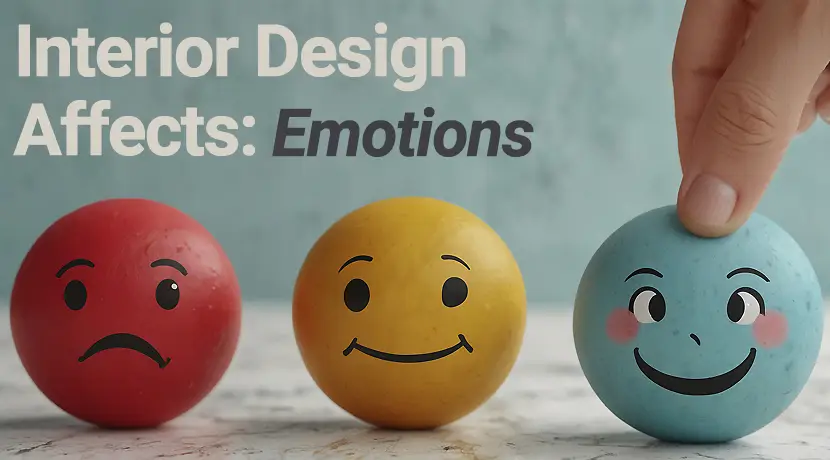How Does Interior Design Affect Our Emotions
Unveiling the Emotional Impact of Interior Design
Have you ever walked into a room and immediately felt a wave of calm wash over you, or perhaps entered a space that seemed to instantly energize your spirit? It’s no coincidence. The spaces we inhabit have a profound influence on our emotional well-being. This intriguing interplay between our surroundings and our emotional states is what we’ll explore as we delve into the question: How does interior design affect our emotions?

The Psychological Power of Color
The Emotional Spectrum of Color Choices
Colors aren’t just a matter of aesthetics; they’re a powerful psychological tool that interior designers wield to evoke specific emotional responses. The concept of color psychology delves into how hues such as serene blues, invigorating yellows, and passionate reds can significantly alter our mood and mental state. Scientific studies, such as those rooted in the principles of Color Theory, have shown that colors can influence everything from stress levels to appetite, making the choice of color palette in a room far from arbitrary.
Lighting: Setting the Emotional Tone
The interplay between color and lighting can amplify or soften the emotional impact of a space. Natural light, for instance, is associated with increased happiness and productivity, as highlighted in a study published in the Journal of Environmental Psychology. The strategic use of lighting, whether it’s the warm glow of incandescent bulbs or the cool brightness of LEDs, can enhance the psychological effects of color, further influencing our emotional state.
Space and Structure: The Framework of Feeling
The Influence of Open vs. Closed Spaces
The architectural layout of a space—whether it’s an open-plan design or a more compartmentalized structure—can significantly affect our emotions. Open spaces often promote feelings of freedom and creativity, facilitating social interactions and collaboration. On the other hand, smaller, closed spaces might foster a sense of coziness and privacy but could also induce feelings of confinement or isolation if not designed thoughtfully.
Personalization: A Reflection of the Self
The extent to which a space allows for personalization can also play a crucial role in emotional well-being. Spaces that reflect an individual’s personality, interests, and experiences can foster a sense of belonging and identity. This aspect of interior design, rooted in environmental psychology, emphasizes the importance of personal spaces that resonate on a deeply personal level, contributing to overall emotional health.
Texture and Material: The Tactile Impact on Emotion
The Sensory Experience of Textures
The tactile elements in a room, from the softness of a plush rug to the smoothness of polished wood, engage our sense of touch and contribute to the room’s overall emotional tone. The psychological effects of tactile stimulation, as studied in the field of haptic perception, show that textures can elicit a wide range of emotions, from the comfort evoked by soft fabrics to the stark, industrial feel of concrete and metal.
Incorporating Natural Elements for Emotional Balance
The incorporation of natural materials and elements, a principle known as biophilic design, taps into our innate connection to nature and can profoundly influence our emotional state. The use of wood, stone, water features, and plant life not only adds aesthetic value but also promotes relaxation, reduces stress, and enhances mental well-being, as supported by numerous studies in environmental psychology.
In conclusion, the question of how interior design affects our emotions opens up a vast landscape of psychological interplay between space, color, light, texture, and personal expression. By understanding and harnessing these elements, we can create environments that not only reflect our aesthetic preferences but also nurture our emotional and mental health.

FAQs on the Emotional Influence of Interior Design
How does the color scheme of a room affect our mood? The colors chosen for a room’s scheme can have a significant impact on our mood and emotions. For instance, blues and greens are often associated with calmness and serenity, while reds and oranges might stimulate energy and appetite. The psychology behind color preferences and perceptions is rooted in Color Theory, which explains how different hues can evoke specific emotional responses.
Can the layout of a room really influence how we feel? Absolutely. The layout of a room can greatly influence our emotions and behavior. Open-plan layouts tend to encourage social interaction and a sense of freedom, while more segmented spaces can offer privacy and coziness. The architectural design of a space, therefore, plays a crucial role in shaping our emotional environment.
Why is personalization in interior design important for emotional well-being? Personalization in interior design is key to creating a space that feels like a reflection of oneself, which is important for emotional well-being. When our surroundings resonate with our personal story, interests, and preferences, it fosters a sense of identity and belonging, contributing to a positive emotional state.
How do textures in interior design influence our emotional state? Textures in interior design engage our sense of touch and can significantly influence our emotional state. Soft, plush textures can evoke feelings of comfort and security, while rough, natural textures like wood and stone can bring a sense of grounding and connection to nature, promoting relaxation and well-being.
What role does natural light play in our emotional response to a space? Natural light plays a significant role in our emotional response to a space. Exposure to natural light has been linked to improved mood, increased productivity, and better overall mental health. The strategic use of natural light in interior design can help create an environment that supports emotional and psychological well-being.





